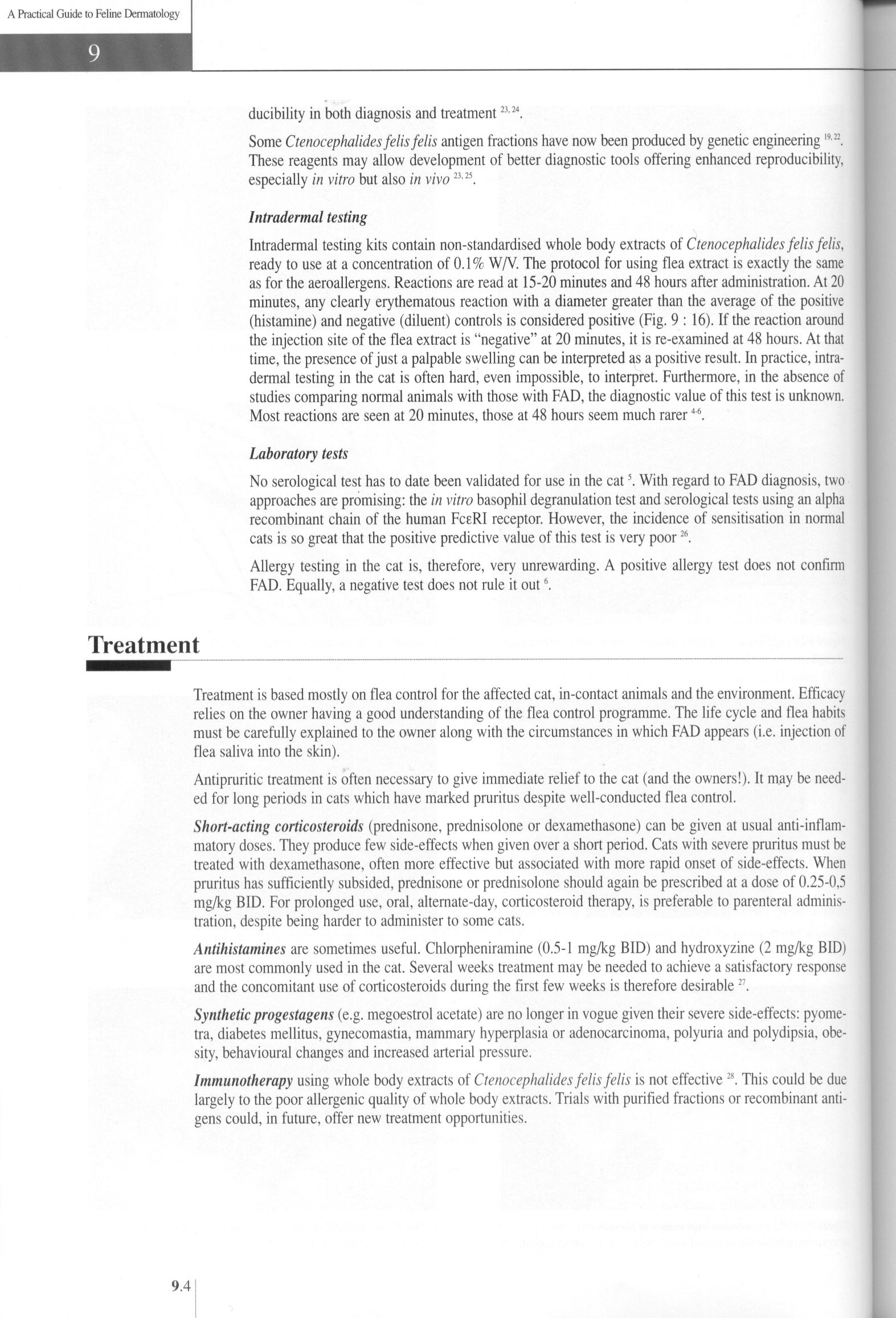94 (68)

9
A Practical Guide to Feline Detmatology
ducibility in both diagnosis and treatment 23,24.
Some Ctenocephalides felis felis antigen fractions have now been produced by genetic engineering19,a. These reagents may allow development of better diagnostic tools offering enhanced reproducibility, especially in vitro but also in vivo23,2S.
Intradermal testing
Intradermal testing kits contain non-standardised whole body extracts of Ctenocephalides felis felis, ready to use at a concentration of 0.1% W/V. The protocol for using flea extract is exactly the same as for the aeroallergens. Reactions are read at 15-20 minutes and 48 hours after administration. At 20 minutes, any clearly erythematous reaction with a diameter greater than the average of the positive (histaminę) and negative (diluent) Controls is considered positive (Fig. 9 : 16). If the reaction around the injection site of the flea extract is “negative” at 20 minutes, it is re-examined at 48 hours. At that time, the presence of just a palpable swelling can be interpreted as a positive result. In practice, intradermal testing in the cat is often hard, even impossible, to interpret. Furthermore, in the absence of studies comparing normal animals with those with FAD, the diagnostic value of this test is unknown. Most reactions are seen at 20 minutes, those at 48 hours seem much rarer4'6.
Laboratory tests
No serological test has to datę been validated for use in the cat5. With regard to FAD diagnosis, two approaches are promising: the in vitro basophil degranulation test and serological tests using an alpha recombinant chain of the human FceRI receptor. However, the incidence of sensitisation in normal cats is so great that the positive predictive value of this test is very poor26.
Allergy testing in the cat is, therefore, very unrewarding. A positive allergy test does not confirm FAD. Eąually, a negative test does not rule it out6.
Treatment
Treatment is based mostly on flea control for the affected cat, in-contact animals and the environment. Efficacy relies on the owner having a good understanding of the flea control programme. The life cycle and flea habits must be carefully explained to the owner along with the circumstances in which FAD appears (i.e. injection of flea saliva into the skin).
Antipruritic treatment is often necessary to give immediate relief to the cat (and the ownersl). It may be need-ed for long periods in cats which have marked pruritus despite well-conducted flea control.
Short-acting corticosteroids (prednisone, prednisolone or dexamethasone) can be given at usual anti-inflam-matory doses. They produce few side-effects when given over a short period. Cats with severe pruritus must be treated with dexamethasone, often morę effective but associated with morę rapid onset of side-effects. When pruritus has sufficiently subsided, prednisone or prednisolone should again be prescribed at a dose of 0.25-0,5 mg/kg BID. For prolonged use, orał, alternate-day, corticosteroid therapy, is preferable to parenteral administration, despite being harder to administer to some cats.
Antihistamines are sometimes useful. Chlorpheniramine (0.5-1 mg/kg BID) and hydroxyzine (2 mg/kg BID) are most commonly used in the cat. Several weeks treatment may be needed to achieve a satisfactory response and the concomitant use of corticosteroids during the first few weeks is therefore desirable27.
Synthetic progestagens (e.g. megoestrol acetate) are no longer in vogue given their severe side-effects: pyome-tra, diabetes mellitus, gynecomastia, mammary hyperplasia or adenocarcinoma, polyuria and polydipsia, obe-sity, behavioural changes and increased arterial pressure.
Immunotherapy using whole body extracts of Ctenocephalides felis felis is not effective 28. This could be due largely to the poor allergenic ąuality of whole body extracts. Trials with purified fractions or recombinant anti-gens could, in futurę, offer new treatment opportunities.
Wyszukiwarka
Podobne podstrony:
222 (33) 22 A Practical Guide to Feline Dermatology AnimaTs way of life and environment: cats that l
58 (148) 5 A Practical Guide to Feline Dermatology severity of the illness. High titres are seen wit
65 (127) 6 A Practical Guide to Feline Dermatology Other topical antimicrobial agents, such as chlor
67 (125) 6 A Practical Guide to Feline DermatologyNocardiosisAetiopathogenesis Nocardiosis is a very
69 (119) 6 A Practical Guide to Feline DermatologyDiagnosis The diagnosis is based on lesion distrib
710 (2) 7 A Practical Guide to Feline DermatologyHerpesvirus infections Dermatological manifestation
74 (105) 7 A Practical Guide to Feline Dermatology ulcerated. Lesion distribution is multicentric bu
27 A Practical Guide to Feline Dermatology Perianal glands 1.7 Permethrin 3.12, 3.13 Persian 1.6,2.2
27 A Practical Guide to Feline Dermatology Stemphyllium spp. 5.1,7.8 Stereotypie behaviour 17.1,
272 (16) 27 A Practical Guide to Feline Dermatology Alternaria spp. 5.1,7.8 Aluminium hyroxide 15.6&
274 (18) 27 A Practical Guide to Feline Dermatology Colitis 11.2 Collagen 1.2,2.6,12.1,
276 (17) 27 Practical Guide to Feline Deimatology junctional 16.6-8 Epitheliotropic T celi
278 (17) 27 A Practical Guide to Feline Dermatology I J Histoplasmosis 5.8, 7.8, 25.2 Homer’s syndro
28 (374) 2 A Practical Guide to Feline Dermatology Configuration of lesions Determining the configur
313 (14) A Practical Guide to Feline Dermatology The second phase consists of long-term control of t
31 (328) 3 A Practical Guide to Feline Dermatology Sarcoptic mange Sarcoptes scabiei var canis (Tabl
82 (128) 8 A Practical Guide to Feline Dermatology considered important parasites. Cats in the Unite
84 (117) 8 A Practical Guide to Feline Deimatology conditions are optimal, flea populations can grow
42 (226) 4 A Practical Guide to Feline Dermatology Increased hydration and subsequent maceration of
więcej podobnych podstron